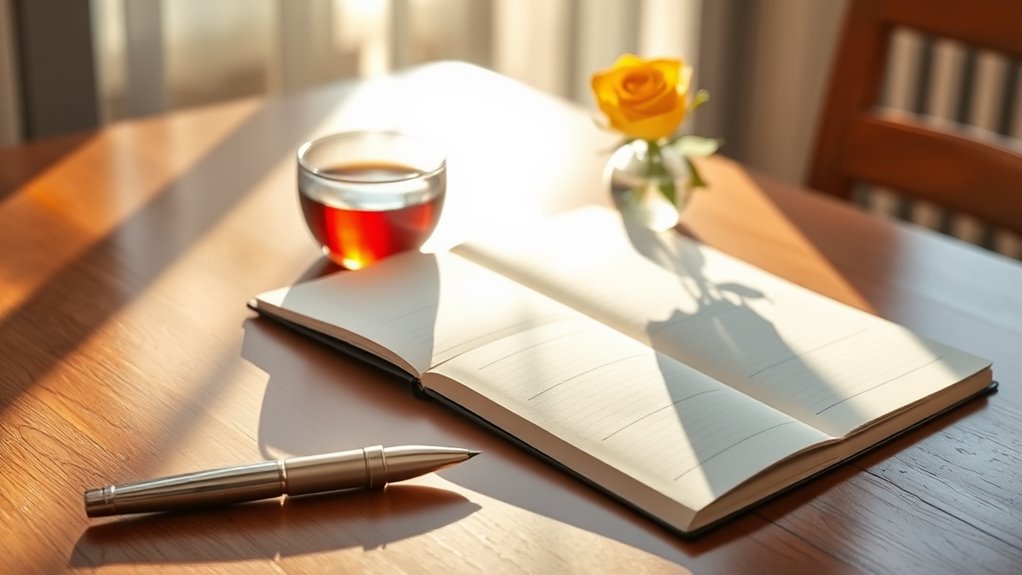Increase Gratitude With These Life-Changing Techniques!
You can increase your gratitude by practicing daily journaling, mindfulness meditation, or creating a gratitude jar. Express appreciation to others and reflect on past experiences for deeper insights. Use gratitude affirmations to shift your mindset and engage in random acts of kindness to spread positivity. Setting reminders can help you stay focused on gratitude throughout the day. Explore these techniques to transform your outlook and enhance your sense of gratitude in meaningful ways.
Key Takeaways
-
Practice daily journaling by writing down three things you’re grateful for to enhance positivity and mindfulness.
-
Create a gratitude jar, adding daily notes of appreciation to reflect on joyful moments over time.
-
Engage in mindfulness meditation to foster present-moment awareness and deepen your appreciation for life’s simple joys.
-
Commit to expressing gratitude to others regularly through notes or compliments to strengthen relationships and boost your own happiness.
-
Incorporate random acts of kindness into your routine, spreading positivity and amplifying your sense of fulfillment and gratitude.
The Power of Daily Journaling
Daily journaling can be a powerful tool for cultivating gratitude in your life. By regularly recording your thoughts, you refine your focus on the positive aspects of each day. Start by devoting a few minutes to jot down three things you’re grateful for—no matter how small.
This practice sharpens your awareness of life techniques that elevate your mood and enhance your perspective. As you track moments of appreciation, you’ll notice patterns and uncover deeper layers of joy that may otherwise go unnoticed.
Challenge yourself to write daily; it’s a transformative discipline that shifts your mindset. Over time, you’ll find that gratitude flows more naturally, enriching your experience and influencing those around you.
Incorporating journaling tips can elevate your gratitude practice and help you deepen your appreciation for life’s everyday moments.
Begin this life-changing journey with just a pen and paper.
Practicing Mindfulness Meditation
Building on the insights from daily journaling, practicing mindfulness meditation offers another powerful avenue to deepen your gratitude. By focusing your attention on the present moment, you can cultivate a heightened awareness of your thoughts and feelings.
Start with a few minutes each day, sitting comfortably and closing your eyes. Breathe deeply, anchoring your awareness in the sensation of your breath. As distractions arise, gently return to your breathing.
This practice helps you observe and appreciate the richness of your experiences without judgment. Over time, you’ll notice a shift—recognizing and valuing simple joys. Engaging in mindfulness meditation can significantly enhance feelings of gratitude, allowing you to better appreciate the small wonders of everyday life.
Embrace this clarity, and allow it to foster a deeper sense of gratitude that permeates all aspects of your life.
Cultivating a Gratitude Jar
Creating a gratitude jar is a simple yet effective way to appreciate the positives in your life.
You’ll need a jar, some paper, and a pen to start writing daily gratitude entries.
As you fill the jar, you’ll find joy in reflecting on those memories and how they’ve shaped your outlook. Moreover, incorporating gratitude journaling into your routine can amplify the benefits of this practice.
Materials Needed For Jar
To cultivate a gratitude jar, you’ll need just a few simple materials that can enhance your reflection process. First, select a container—glass or ceramic works best, but choose one that resonates with you.
You’ll also need small pieces of paper or sticky notes to jot down your gratitude entries. Consider using different colors for variety, which can make the experience visually stimulating.
A writing instrument, like a pen or pencil, is essential for capturing your thoughts. Finally, find a comfortable spot to place your jar, somewhere you’ll consistently be reminded to engage with it.
Daily Gratitude Entries
As you begin your daily gratitude entries, take a moment to reflect on the positive aspects of your life, no matter how small they may seem.
Each day, grab a piece of paper and jot down one to five things you appreciate. Be specific—identify the moments or people that spark joy.
Fold each entry and place it in your gratitude jar, watching it fill up over time. This simple ritual not only teaches mindfulness but serves as a tangible reminder of life’s abundance.
Challenge yourself to keep this practice consistent; the cumulative effect will deepen your sense of gratitude.
You’ll find that even in challenging times, your jar will hold countless reminders of positivity and joy.
Reflecting On Memories
Reflecting on memories is a powerful way to deepen your gratitude practice. One simple yet transformative technique is to create a gratitude jar. Each week, jot down moments you’re thankful for on small slips of paper and place them in the jar. Over time, you’ll build a vibrant collection of positive memories to revisit.
| Moment | Emotion | Lesson Learned |
|---|---|---|
| Family gathering | Joy | Importance of connection |
| Achieving a goal | Pride | Hard work pays off |
| A kind gesture | Warmth | Kindness is impactful |
| Overcoming a challenge | Resilience | Growth comes from adversity |
This practice not only fosters appreciation but also serves as a powerful reminder of life’s blessings.
Expressing Appreciation to Others
Expressing appreciation to others not only strengthens relationships but also fosters a positive environment around you.
To master this essential skill, consider these techniques:
-
Be Specific: Don’t just say “thank you”; explain what you appreciate. For example, “I’m grateful for the way you listened during our meeting. It made me feel valued.”
-
Use Various Mediums: Share your appreciation through handwritten notes, verbal compliments, or digital messages. Different formats can create a more personal touch.
-
Make it a Daily Habit****: Look for opportunities every day to express gratitude. Whether it’s a colleague, friend, or family member, acknowledging their impact strengthens connection. Practicing gratitude through expression can lead to improved mental well-being, making your interactions even more meaningful.
Reflecting on Past Experiences
When you take time to reminisce about significant moments in your life, you uncover valuable lessons and insights that can shape your current mindset.
Reflecting on both triumphs and challenges allows you to appreciate how far you’ve come. Each experience, whether joyous or painful, taught you resilience and strength.
Focus on pivotal events, noting what you learned from them. This practice not only cultivates gratitude but also enhances self-awareness, empowering you to make informed choices moving forward. Engaging in daily gratitude rituals can help solidify this reflection process and amplify overall well-being.
Keep a journal dedicated to these reflections, as writing solidifies your insights. When you recognize the growth stemming from your experiences, you’ll foster a deeper sense of appreciation for today’s journey and be motivated to embrace future challenges with open arms.
Creating Gratitude Affirmations
Gratitude affirmations can transform your mindset and enhance your overall well-being. By regularly practicing these affirmations, you cultivate a more positive outlook on life.
Here’s how to create effective gratitude affirmations:
-
Be Specific: Identify particular aspects of your life you’re grateful for, such as relationships, health, or opportunities. This specificity deepens your commitment.
-
Use the Present Tense****: Phrase your affirmations as if they’re currently true. For example, say “I am grateful for my supportive friends” instead of “I will be grateful for my supportive friends.”
-
Infuse Emotion: Connect with the feelings behind your affirmations. Let joy and appreciation resonate as you recite them, making your practice more powerful.
Incorporating these techniques will enhance the effectiveness of your gratitude affirmations.
Engaging in Random Acts of Kindness
Engaging in random acts of kindness not only brightens someone else’s day but also boosts your own sense of fulfillment. These simple gestures can create a ripple effect, spreading positivity and gratitude in your life. Consider how impactful your actions can be:
| Act of Kindness | Emotional Impact |
|---|---|
| Compliment a stranger | Sparks joy in both hearts |
| Offer assistance to someone | Builds community connection |
| Leave a note of appreciation | Inspires gratitude ripple |
| Donate to a local cause | Fosters hope and support |
| Share your favorite book | Shares knowledge and love |
Setting Gratitude Reminders
To make gratitude a daily habit, you need effective reminders.
Consider using daily affirmation prompts, visual tools, and scheduled reflection times to keep gratitude at the forefront of your mind.
These techniques can help you cultivate a more positive outlook on life.
Daily Affirmation Prompts
How often do you take a moment to appreciate the little things in your life? Daily affirmations are a powerful way to cultivate gratitude and shift your mindset. They remind you of what truly matters.
To enhance this practice, consider these prompts:
- I’m grateful for ______ because it brings me joy.
- I appreciate the support of ______ in my life.
- Today, I’m thankful for ______ and its impact on my well-being.
Fill in the blanks with specific thoughts and feelings. Repeat these affirmations aloud or jot them down each day.
This simple technique can transform your perspective, anchoring you in gratitude and encouraging a deeper appreciation for your everyday experiences.
Harness these prompts, and watch your gratitude grow!
Visual Reminder Tools
Daily affirmations can set a strong foundation for gratitude, but visual reminder tools enhance this practice even further. Using affirming images, quotes, or symbols fosters a daily connection to gratitude.
Place these reminders in high-traffic areas—your bathroom mirror, computer desktop, or fridge. Create a gratitude jar, filling it with notes of thankful moments that you can revisit.
Consider a vision board, showcasing your goals alongside images of things you’re grateful for. Each visual serves as a nudge, pulling you back to a mindset of appreciation.
Scheduled Reflection Times
While incorporating gratitude into your life is essential, scheduling specific times for reflection can deepen that practice and guarantee it becomes a priority. By intentionally setting aside time, you make gratitude an active part of your routine.
Here are three ways to create scheduled reflection times:
-
Daily Journaling: Choose a time each day to jot down what you’re grateful for; this cultivates a habit and reinforces positivity.
-
Weekly Reviews: Dedicate a specific time each week to reflect on your experiences, focusing on what brought you joy or learning.
-
Monthly Gratitude Goals: Set a day each month to look back over what you’ve found gratitude in and establish new intentions moving forward.
This structure not only grounds you but also enhances your awareness of gratitude’s impact in your life.
Frequently Asked Questions
How Does Gratitude Impact Mental Health Scientifically?
Gratitude considerably boosts your mental health by enhancing mood, reducing stress, and fostering resilience. It activates brain regions linked to reward processing, leading to improved overall well-being and encouraging positive emotions in daily life.
Can Gratitude Help Improve Relationships?
Practicing gratitude strengthens your connections by fostering appreciation and understanding. When you express gratitude, you create a positive environment, encouraging open communication and deepening emotional bonds, which leads to healthier, more satisfying relationships.
What Are the Long-Term Effects of Practicing Gratitude Daily?
Practicing gratitude daily is like watering a garden; it nurtures flourishing relationships, boosts resilience, and cultivates happiness. Over time, you’ll find your mindset shifts, leading to deeper connections and a brighter outlook on life.
How Do Cultural Differences Affect Expressions of Gratitude?
Cultural differences shape how you express gratitude. In some cultures, formal gestures signify respect, while in others, casual expressions foster connection. Understanding these nuances helps you navigate interactions and strengthen relationships across diverse backgrounds.
Are There Any Risks Associated With Forced Gratitude?
Forcing gratitude can feel like wearing a mask—eventually, it suffocates authenticity. Risks include emotional disconnection, resentment, and superficial relationships. Embrace genuine moments instead; your connections will bloom and flourish with sincere appreciation.





